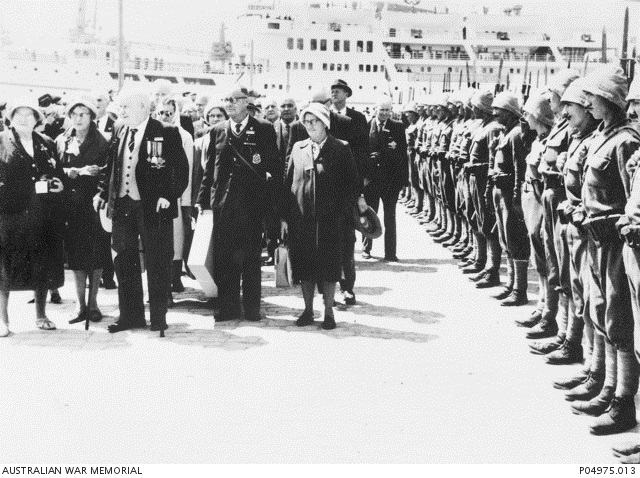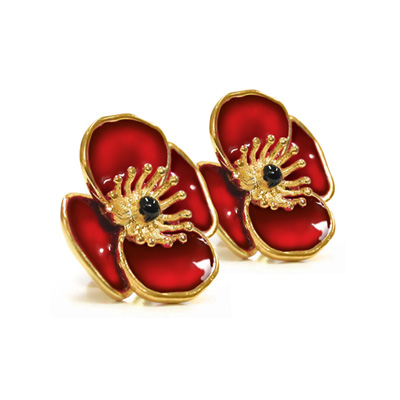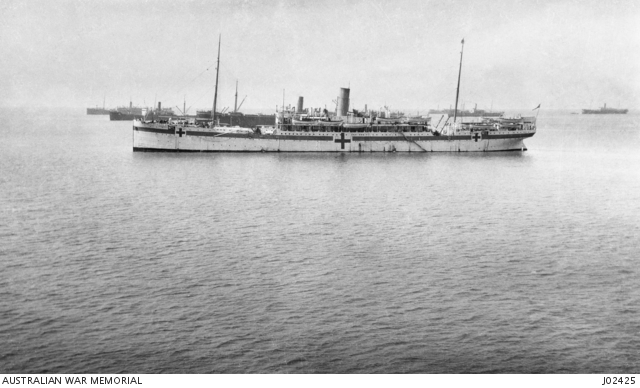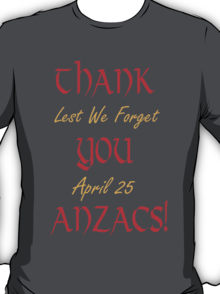‘Speech to UNSW History Teachers’ Summer School, National Press Club, Canberra, 22 January 2015′, Honest History, 3 February 2015
Thank you. I am very grateful for the opportunity to speak to an audience that includes secondary school historians as well as colleagues from the university sector. For reasons that I will explain I think that you have a very important role to play over the next four years of Anzac centenary commemorations.
 Children finding the best vantage point to watch the Anzac Day march, Melbourne, 1943 (Australian War Memorial 138745/)
Children finding the best vantage point to watch the Anzac Day march, Melbourne, 1943 (Australian War Memorial 138745/)
It has been a long time since I studied history at high school. My only brushes with school history in recent years have been through my role as a parent. For several years now I have spoken at my daughters’ primary school around the time of Anzac Day.
The transition from academic history to primary school history is always a challenge. What do you say to primary school kids about the First World War in half an hour? I tend to tell them some basic facts about who fought and how many people died. I show lots of pictures—I like to show images of Pozieres village before and after the battle of 1916. I always take in objects to show the kids—a helmet from World War One, some shell casings, a water bottle — which are well-received.
My favourite part is always the questions afterwards. The boys want to ask about the weapons. They ask questions that I am ill-equipped to answer, like what was the biggest shell, how far could machine guns fire, did they use swords, did they fight with their hands? Boys get particularly excited about violence and bloodshed. When you combine that with their tendency for quantification, it makes for interesting questions. Last year, one little boy asked me how many buckets of blood there were. Another asked how many heads were blown off.
I had my first interaction with secondary history students last year, when I spoke to Year 9 students at my daughter’s high school. The most memorable thing about the occasion was my realisation of how uncool history is to thirteen-year-old girls. My daughter, who was in Year 7, was genuinely mortified at the prospect that the Year 9s might realise that I was her mum. I was instructed very carefully not to mention anything that might betray a family connection. Fortunately for my daughter we have different surnames, so her secret was safe.
The topic I talked to the Year 9 students about is no doubt familiar to you: ‘The 2015 Anzac Centenary is a time for us to reflect on the Anzac spirit. To what extent do you think it is relevant today? What can it teach us about the Australia we want for the future?’
In the absence of much instruction from the teachers, I decided that I would talk to the girls about the history of the Anzac legend in Australia. I talked about how the Anzac legend had changed over the course of the twentieth century, from an idea grounded in British race patriotism and imperialism to something that reflected contemporary concerns with trauma and espoused motherhood values like mateship, sacrifice and endurance.
We ran out of time for questions at the end of the talk, so I urged the girls to contact me by email if they had any questions. A couple of weeks after the high school talk, Professor Stuart Macintyre from Melbourne University launched my book about the history of Great War memory in Australia. As you probably know, Stuart led the development of the national history curriculum. At the launch he said: ‘If the study of history is to have any value, it has to take you outside your own past, to confront you with the different and the unfamiliar, to force you to think beyond your assumptions.’
 Turkish soldiers in 1915 uniforms welcome Australian veterans and wives, April 1965 (Australian War Memorial P04975.013)
Turkish soldiers in 1915 uniforms welcome Australian veterans and wives, April 1965 (Australian War Memorial P04975.013)
This meant that Australian history, including the experience of the Great War, had to be studied in the context of world history. This approach was supported by the teachers, but not by the curriculum authority, it seems. According to Stuart, the authority ‘judged that a curriculum that did not tell of Lone Pine and Pozieres would bring headlines in The Australian and incite Alan Jones, so they reinstated the Anzac story in its familiar current form’. The result was that the Year 9 topic on the Great War ‘treats that story as unproblematic, as if there has been no argument over it and young Australians have been making the pilgrimage to Anzac Cove since 1919’.
The day after the book launch I got an email from one of the Year 9 students. She wrote: ‘I have decided to do my assignment on the Australian firefighters and how they show Anzac Spirit. So, I was wondering if you had any further information about life at home during the Bushfire’s whilst it was World War 1.’
Hmmm. I answered the email as best I could—not being on expert on early twentieth century bushfires—but I did wonder whether anything I said in my talk had sunk in.
Tonight I want to make an argument about how the history of the First World War should be taught to Australian school children. I agree with Stuart that we need to teach our children about the Australian experience of World War One within a broader, international setting. But I think we should go further. I believe that we need to educate our children, and indeed broader society, about the fact that Anzac commemoration itself has a history. That the ‘spirit of Anzac’ did not descend in its present form on 25 April 1915. That it has been a dynamic and fascinating phenomenon. And, in its changing forms over the course of a century, the Anzac legend has held a mirror to Australian society.
An understanding of the history of the Anzac legend also promises to provide some much-needed context for the current state of Anzac commemoration. Let me show you some figures that illustrate just how unusual the contemporary Australian relationship to Great War memory is. This is how much money various national governments are spending on commemorations for the centenary of the First World War: Britain $90m; France $90m; Germany $7m; Australia $145m.
Perhaps the best comparison, in terms of comparing like with like, is between Australia and two other British settler nations who fought in the Great War, New Zealand and Canada. New Zealand has committed $16 million to the centenary. Canada is allocating no new money. When you combine the Commonwealth’s contribution of $145m with the states and territories, which are kicking in $80m, and the private sector, which has promised $170m, you reach a staggering total of $395m.
 Isabelle Cornish, Australian actor and Camp Gallipoli ambassador (Camp Gallipoli promotion image)
Isabelle Cornish, Australian actor and Camp Gallipoli ambassador (Camp Gallipoli promotion image)
And what about the commercialisation of Anzac? Anzac is arguably the most revered and potent brand in Australia today. Despite laws restricting the use of the word ‘Anzac’, companies find ways and means to associate themselves with the brand. The favoured method is what is called ‘cause marketing’, where a company donates some of its profits towards an admirable cause, in this case it is usually Legacy and the RSL. You may have seen the television advertisement a couple of years ago, where Peter Cosgrove, now Sir Peter the Governor-General, urged Australians to ‘raise a glass’ for the Anzacs, as he raised a glass of VB.
If you have concerns about the morality of associating alcohol with war commemoration, you might prefer the Anzac Run, whose motto is ‘Exercise your Freedom’. Continuing the outdoors theme is Camp Gallipoli. On 24 April this year, at venues around Australia and in New Zealand, people can camp out under the stars. As the event website points out, these are the very same stars that the Anzacs slept under one hundred years ago. For $275, participants can purchase an historic replica swag, just like the ones the Anzacs slept in one hundred years ago.
Camp Gallipoli’s website tells us that ‘the “spirit of Anzac” is in the DNA of every Aussie and Kiwi. It is the one thing that unites Australians and New Zealanders from all walks of life and cultures, rich or poor, young or old.’ Never mind a commitment to democracy, the rule of law, egalitarianism or any of those values we might consider to unite us as Australians.
Cruise ships have jumped on the Anzac centenary bandwagon. Bert Newton is hosting an event called ‘the Gallipoli Cruise’. A sparkling list of on-board entertainers includes Daryl Braithwaite, Kate Ceberano and Normie Rowe. The Gallipoli Cruise has three historians of repute on board—David Horner, Michael O’Brien and Harvey Broadbent.
Crowd numbers at Gallipoli have been strictly limited by the Australian government, so unfortunately cruise passengers will have to watch the Anzac Cove services on the telly like the rest of us. There is no shortage of land-based tours. Mat McLachlan Battlefield Tours makes the bold claim that ‘a visit to Gallipoli for Anzac Day is a life-changing experience’. You won’t find Bert Newton or Normie Rowe on a Mat McLachlan Tour, but the company does boast none other than ADFA’s own Michael Molkentin!
I am allowed to be cynical about these tours because I was not invited to be on one. It’s not a case of sour grapes at all. Not all of the events that bear the Anzac or Gallipoli branding are commercially driven. The cruises and tours clearly are, but things become more obscure with something like Camp Gallipoli. According to Camp Gallipoli’s website, ‘all surplus’ money is being directed towards the RSL and Legacy, but I have not been able to discover how much is going into the organisers’ pockets before they reach ‘surplus’.
 Gallipoli Cruise ship; Hospital ship ‘Soudan’ off Anzac, 25 April 1915 (Australian War Memorial J02425)
Gallipoli Cruise ship; Hospital ship ‘Soudan’ off Anzac, 25 April 1915 (Australian War Memorial J02425)
There is, however, no doubting the motives of companies peddling Anzac-related merchandise on the internet. You would not believe some of the stuff. You can decorate your kitchen with Gallipoli oven mitts and pot holders. There’s a fridge magnet with a recreation of a trench from World War One on it, so you remember the Anzacs every time you open the fridge … to grab that VB, to ‘raise a glass’. You can wrap your little one in an ‘Anzac Day thank you baby blanket’. And pop a hat on your baby’s head that’s decorated with Flanders poppies. For the woman who has everything, there are ‘Sands of Gallipoli Centenary poppy ear rings’. The earrings come with a matching apron.
Blokes can choose from a range of t-shirts with slogans such as ‘Thank you Anzacs, Lest we Forget April 25’. Only the predestined few can wear t-shirts that simply say ‘Anzac Descendant’ or ‘Proud Son of an Anzac’.
I was confused by the t-shirt depicting Simpson and his donkey. I couldn’t work out why Ned Kelly was riding the donkey! And I was gob-smacked by the ‘Anzac Pin-Up Girl’ t-shirt, featuring a very large-breasted woman in skimpy khaki latex, wearing a helmet and suggestively brandishing a rifle.
Anzac porn—a new low in the commercialisation of Anzac. Apart from being amusing in its crassness, this flood of Anzac merchandise is symptomatic of a serious issue. We need to immunise our children against political manipulation and commercial exploitation. Not by denigrating the Anzacs—it is important that we honour their memory and never forget their suffering. But by providing facts in place of puff and propaganda, and allowing children to make up their own minds.
For example, we should teach our children how the Anzac legend took root in Australia. How did a small country in the Asia-Pacific come to embrace a failed campaign in Turkey as its founding mythology? It is sometimes said that the Anzac legend was created by the official correspondent and official historian, Charles Bean, or the British journalist, Ellis Ashmead-Bartlett. I don’t subscribe to the view that the Anzac legend was imposed upon a passive Australian population. In my view it was the conjunction of three factors that made such fertile ground for the legend to take root:
- First, we were a new nation in 1915, more a loosely federated collection of states than a nation united. The experience of fighting as Australians did much to advance a feeling of nationhood.
- Second, the notion was about in the late nineteenth and early twentieth centuries that nations were made in war. By federating peacefully in 1901, Australians had been deprived of the ‘transcendent test’ of manhood and nationhood provided by battle. The Boer War had proved inadequate as a nation-making war. The Great War did not.
- And third, Australians felt a deep shame and sense of inferiority about their convict origin. The sterling performance of their soldiers was proof that Australians were not the degenerate sons of convict stock. The martial baptism at Gallipoli offered an historical ground zero, a moment at which Australian history could be remade.
The Anzac legend in its original form was steeped in the ideals of early twentieth century Australia. These ideals included: a belief in the superiority of the white races; a deep attachment to Great Britain; and traditional gender roles for men and women. This model of Anzac commemoration remained in place for a good forty years. But by the 1960s it had begun to crumble. As the baby boomers reached maturity they questioned the values of the Great War generation. Alan Seymour’s famous play The One Day of the Year dramatised the generational divide between the baby boomers and their parents and grandparents. The occasion on which Australia became a nation, according to the Anzac generation, was, in the baby boomers’ eyes, a day of ‘bloody wastefulness’ perpetuated year after year by a ‘screaming tribe of great, stupid, drunken, vicious, bigoted no-hopers’.
 T-shirt with Rising Sun badge, made in San Jose, California, and advertised as ‘ANZAC Pin-up Girl T-shirt‘, $37.95
T-shirt with Rising Sun badge, made in San Jose, California, and advertised as ‘ANZAC Pin-up Girl T-shirt‘, $37.95
The Vietnam War gave momentum to anti-Anzac sentiment that was already building in the community. By the late 1960s, any kind of war commemoration came to be seen by a large portion of the population as equivalent to the glorification of war.
The critique of the Anzac legend continued through the 1970s and into the 1980s. In the early to mid-80s, radical feminists targeted Anzac Day marches. Notoriously, they called the old Diggers limping along or being pushed in their wheelchairs ‘rapists’ and ‘murderers’. In 1986 a columnist in the Canberra Times newspaper asked, ‘How long will Anzac Day keep going?’ He wrote, ‘I’m pleased to see that we’re still having Easter once a year … and I’d like to think that Anzac Day could last as long. But you and I know that’s not possible.’
Far from being impossible, thirty years after that article was written, Anzac Day is bigger than Easter. We should not take this revival for granted, but think hard about how and why it has happened. Our children should know about the changing role of politicians in Anzac commemoration. It is not as if prime ministers have been boarding ships and planes bound for Turkey each Anzac Day since the days of Billy Hughes and Stanley Bruce. Malcolm Fraser told me that if he had gone to Gallipoli when he was prime minister, people would have said, ‘What on earth is Fraser doing?’
Bob Hawke was the first prime minister to go to Gallipoli for Anzac Day. He only went after his government made a calculated judgement that the tide of public opinion was turning back towards Anzac commemoration. Hawke’s trip in 1990 with elderly diggers for the 75th anniversary of the Gallipoli landing was a great success. The ‘pilgrimage’, as it was called, signalled the beginning of the great modern love affair between Australian prime ministers and Anzac. Nowadays, no prime minister (with the exception of Paul Keating) would miss an opportunity to pop over to Turkey in late April as soon as the schedule allowed.
John Howard was remarkably successful in tailoring traditional Anzac values such as mateship and egalitarianism to his political cause. Anzac remains front and centre in the political battle over Australian nationalism. When a rumour spread last year that funding might be cut for the travelling Anzac Centenary Exhibition, Bill Shorten was quick to criticise the government in an effort to gain political advantage. The government just as quickly assured the public that there would be no cut to funding. Tony Abbott and Joe Hockey are still struggling to find savings in this atmosphere of alleged Budget crisis. But no sane politician would dare cut funding for the Anzac centenary.
 Sands of Gallipoli centenary poppy ear-rings, $10-17
Sands of Gallipoli centenary poppy ear-rings, $10-17
In conclusion, when I gave a lecture to Melbourne University students about the history of Anzac commemoration in 2013, one of the students approached me afterwards and told me that she felt like she had been brainwashed. She said that she had no idea that Anzac was not always the incredibly important occasion it had been for as long as she could remember.
I don’t want to go so far as to claim that Australians are being brainwashed. I think that a lot of people who are passionate about Anzac commemoration have pure motives. I just want people, especially our young people, to be vigilant about what is being dished up to them as history.
I believe that an understanding of how the Great War has been remembered in Australia is crucial in this current atmosphere of Anzac madness. And lastly, I believe that you, as history teachers, have a crucial role as the gatekeepers of honest history. Thank you.




Thank you Carolyn. I saw you on Q&A last night and was astounded at your comment about what we are spending on the WW1 centenary ‘celebrations’, because that is what they seem to be. I Googled you and found this article of yours, and of course I had to add my two bob’s worth.
Like so many people I know, every ANZAC Day and at other times during the year I feel irritated, almost angry, at the relentless promulgation of the idea that Australian mateship began at Gallipoli. The research I undertook for my book ‘Robert Forrester, First Fleeter’ informed me that mateship began in 1787, on the long voyage on the transport ships, in the loneliness and isolation of an ’empty’ country, and in the famine, droughts and twenty five years of flood disasters at the Hawkesbury when it was the food bowl for the colony. The earliest newspaper accounts of how people helped each other at the Hawkesbury proves my point about mateship.
Egalitarianism began with our first impressive Governor, Arthur Phillip – weren’t we lucky to have him as our founding father, but how many Australians know about him?
I’ve just finished drafting a book based on the letters my Boulton great-uncles wrote to their mother in Sydney during the entirety of WW1. To me, the interesting point in those letters is the concept of home. Whilst ‘home’ meant the house where their mother lived, with its comforting food and bed, their letters otherwise said ‘home to England’ and ‘back to Australia’. But, by the end of the war, their personal identity was as Australians. Having tested themselves against the men from other countries, they were proud of what they could achieve. I think this was a major lesson of the war. No more cultural cringe – well, a lot less anyhow.
I think these are the kinds of history lessons we should draw out at Anzac Day.
Don’t get me wrong – I’m an early babyboomer and I’ve seen the waxing and waning and waxing of ANZAC Day. In the fifties I attended ANZAC Day marches in Sydney with my father, until he stopped going. I saw my university friends affected by the ballot for Vietnam. Now I attend the Dawn Service in Melbourne every year that I can, and the ambience, the quiet respect shown by a huge crowd, the Last Post, the traditional poems and hymns and the words from a current serviceman are a very moving experience. Melbourne has no speeches from politicians jumping on the bandwagon, thank goodness, but the occasional jingoistic speech does jar, and this year’s ‘extravaganza’ from a teacher who seriously over-acted made me recoil with distaste.
It does no harm to the memory of courage and bravery to remember the huge cost of WW1 and WW2 and the societal cost we still pay today. Most of my both of grandmothers’ women friends never married and had their own children because so many young men of their day were killed. Many men in my own family and beyond returned damaged for life, physically and mentally. And they still do, from current wars – in every country where war is being waged. That should be a strong message on ANZAC Day, not the glorification of victories and defeats in battle.
Thanks for getting me going. It was great to have a history teacher on Q&A. May there be many more!